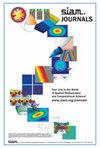基于后验方差的成像逆问题误差量化
IF 2.1
3区 数学
Q3 COMPUTER SCIENCE, ARTIFICIAL INTELLIGENCE
引用次数: 0
摘要
SIAM 影像科学期刊》第 17 卷第 1 期第 301-333 页,2024 年 3 月。 摘要:本文介绍了一种在逆成像问题的贝叶斯正则化中获得像素误差边界的方法。该方法利用后验方差估计和保形预测技术,在不对基础数据分布做任何假设的情况下,获得误差边界的覆盖保证。它普遍适用于贝叶斯正则化方法,与先验的具体选择等无关。此外,在只能对后验进行近似采样的情况下,也能获得覆盖率保证。有了这一点,所提出的框架就能以黑箱方式纳入任何已学先验。由于误差边界的大小一般来说是事先未知的,因此只有在不假设底层分布的情况下才能实现保证覆盖率。尽管如此,本文介绍的多种正则化方法的实验证实,在实践中,所获得的误差边界是相当严格的。为了实现数值实验,本文还引入了一种用于从非光滑分布中采样的新型原始双 Langevin 算法,并在实践中显示出良好的效果。虽然这种基元-双算法的收敛性证明仍未完成,但所提出方法的理论保证并不需要保证采样算法的收敛性。本文章由计算机程序翻译,如有差异,请以英文原文为准。
Posterior-Variance–Based Error Quantification for Inverse Problems in Imaging
SIAM Journal on Imaging Sciences, Volume 17, Issue 1, Page 301-333, March 2024.
Abstract.In this work, a method for obtaining pixelwise error bounds in Bayesian regularization of inverse imaging problems is introduced. The proposed method employs estimates of the posterior variance together with techniques from conformal prediction in order to obtain coverage guarantees for the error bounds, without making any assumption on the underlying data distribution. It is generally applicable to Bayesian regularization approaches, independent, e.g., of the concrete choice of the prior. Furthermore, the coverage guarantees can also be obtained in case only approximate sampling from the posterior is possible. With this in particular, the proposed framework is able to incorporate any learned prior in a black-box manner. Guaranteed coverage without assumptions on the underlying distributions is only achievable since the magnitude of the error bounds is, in general, unknown in advance. Nevertheless, experiments with multiple regularization approaches presented in the paper confirm that, in practice, the obtained error bounds are rather tight. For realizing the numerical experiments, a novel primal-dual Langevin algorithm for sampling from nonsmooth distributions is also introduced in this work, showing promising results in practice. While a proof of convergence for this primal-dual algorithm is still open, the theoretical guarantees of the proposed method do not require a guaranteed convergence of the sampling algorithm.
Abstract.In this work, a method for obtaining pixelwise error bounds in Bayesian regularization of inverse imaging problems is introduced. The proposed method employs estimates of the posterior variance together with techniques from conformal prediction in order to obtain coverage guarantees for the error bounds, without making any assumption on the underlying data distribution. It is generally applicable to Bayesian regularization approaches, independent, e.g., of the concrete choice of the prior. Furthermore, the coverage guarantees can also be obtained in case only approximate sampling from the posterior is possible. With this in particular, the proposed framework is able to incorporate any learned prior in a black-box manner. Guaranteed coverage without assumptions on the underlying distributions is only achievable since the magnitude of the error bounds is, in general, unknown in advance. Nevertheless, experiments with multiple regularization approaches presented in the paper confirm that, in practice, the obtained error bounds are rather tight. For realizing the numerical experiments, a novel primal-dual Langevin algorithm for sampling from nonsmooth distributions is also introduced in this work, showing promising results in practice. While a proof of convergence for this primal-dual algorithm is still open, the theoretical guarantees of the proposed method do not require a guaranteed convergence of the sampling algorithm.
求助全文
通过发布文献求助,成功后即可免费获取论文全文。
去求助
来源期刊

SIAM Journal on Imaging Sciences
COMPUTER SCIENCE, ARTIFICIAL INTELLIGENCE-COMPUTER SCIENCE, SOFTWARE ENGINEERING
CiteScore
3.80
自引率
4.80%
发文量
58
审稿时长
>12 weeks
期刊介绍:
SIAM Journal on Imaging Sciences (SIIMS) covers all areas of imaging sciences, broadly interpreted. It includes image formation, image processing, image analysis, image interpretation and understanding, imaging-related machine learning, and inverse problems in imaging; leading to applications to diverse areas in science, medicine, engineering, and other fields. The journal’s scope is meant to be broad enough to include areas now organized under the terms image processing, image analysis, computer graphics, computer vision, visual machine learning, and visualization. Formal approaches, at the level of mathematics and/or computations, as well as state-of-the-art practical results, are expected from manuscripts published in SIIMS. SIIMS is mathematically and computationally based, and offers a unique forum to highlight the commonality of methodology, models, and algorithms among diverse application areas of imaging sciences. SIIMS provides a broad authoritative source for fundamental results in imaging sciences, with a unique combination of mathematics and applications.
SIIMS covers a broad range of areas, including but not limited to image formation, image processing, image analysis, computer graphics, computer vision, visualization, image understanding, pattern analysis, machine intelligence, remote sensing, geoscience, signal processing, medical and biomedical imaging, and seismic imaging. The fundamental mathematical theories addressing imaging problems covered by SIIMS include, but are not limited to, harmonic analysis, partial differential equations, differential geometry, numerical analysis, information theory, learning, optimization, statistics, and probability. Research papers that innovate both in the fundamentals and in the applications are especially welcome. SIIMS focuses on conceptually new ideas, methods, and fundamentals as applied to all aspects of imaging sciences.
 求助内容:
求助内容: 应助结果提醒方式:
应助结果提醒方式:


